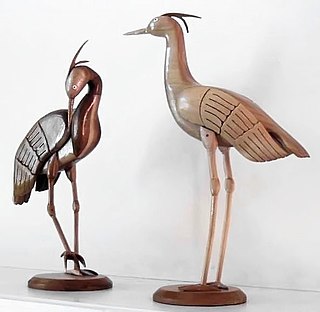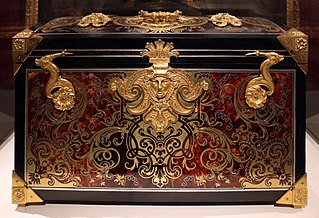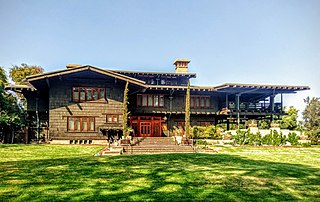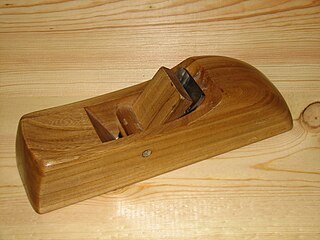
Woodworking is the skill of making items from wood, and includes cabinet making, wood carving, joinery, carpentry, and woodturning.

Furniture refers to movable objects intended to support various human activities such as seating, eating (tables), and sleeping. Furniture is also used to hold objects at a convenient height for work, or to store things. Furniture can be a product of design and is considered a form of decorative art. In addition to furniture's functional role, it can serve a symbolic or religious purpose. It can be made from many materials, including metal, plastic, and wood. Furniture can be made using a variety of woodworking joints which often reflect the local culture.

Marquetry is the art and craft of applying pieces of veneer to a structure to form decorative patterns, designs or pictures. The technique may be applied to case furniture or even seat furniture, to decorative small objects with smooth, veneerable surfaces or to freestanding pictorial panels appreciated in their own right.

Joinery is a part of woodworking that involves joining pieces of wood or lumber, to produce more complex items. Some wood joints employ fasteners, bindings, or adhesives, while others use only wood elements. The characteristics of wooden joints - strength, flexibility, toughness, appearance, etc. - derive from the properties of the materials involved and the purpose of the joint. Therefore, different joinery techniques are used to meet differing requirements. For example, the joinery used to construct a house can be different from that used to make puzzle toys, although some concepts overlap. In British English usage it is distinguished from carpentry which relates to structural timber work.

The Eastlake movement was a nineteenth-century architectural and household design reform movement started by British architect and writer Charles Eastlake (1836–1906). The movement is generally considered part of the late Victorian period in terms of broad antique furniture designations. In architecture the Eastlake style or Eastlake architecture is part of the Queen Anne style of Victorian architecture.

The Gamble House, also known as the David B. Gamble House, is an iconic American Craftsman home in Pasadena, California, designed by the architectural firm Greene and Greene. Constructed in 1908–09 as a home for David B. Gamble of the Procter & Gamble company, it is today a National Historic Landmark, a California Historical Landmark, and open to the public for tours and events.

George Katsutoshi Nakashima was an American woodworker, architect, and furniture maker who was one of the leading innovators of 20th century furniture design and a father of the American craft movement. In 1983, he accepted the Order of the Sacred Treasure, an honor bestowed by the Emperor of Japan and the Japanese government.
David J. Marks is a woodworker living in Santa Rosa, California.

James Krenov was a woodworker and studio furnituremaker.

A butterfly joint, also called a bow tie, dovetail key, Dutchman joint, or Nakashima joint, is a type of joint or inlay used to hold two or more pieces of woods together. These types of joints are mainly used for aesthetics, but they can also be used to reinforce cracks in pieces of wood, doors, picture frames, or drawers.
This glossary of woodworking lists a number of specialized terms and concepts used in woodworking, carpentry, and related disciplines.

A cabriole leg is one of (usually) four vertical supports of a piece of furniture shaped in two curves; the upper arc is convex, while lower is concave; the upper curve always bows outward, while the lower curve bows inward; with the axes of the two curves in the same plane. This design was used by the ancient Chinese and Greeks, but emerged in Europe in the very early 18th century, when it was incorporated into the more curvilinear styles produced in France, England and Holland.

The forms of Chinese furniture evolved along three distinct lineages which dates back to 1000 BC, based on frame and panel, yoke and rack and bamboo construction techniques. Chinese home furniture evolved independently of Western furniture into many similar forms including chairs, tables, stools, cupboards, cabinets, beds and sofas. Until about the 10th century CE the Chinese sat on mats or low platforms using low tables, in typical Asian style, but then gradually moved to using high tables with chairs.

Amish furniture is furniture manufactured by the Amish, primarily of Pennsylvania, Indiana, and Ohio. It is generally known as being made completely out of wood, usually without particle board or laminate. The styles most often used by the Amish woodworkers are generally more traditional in nature.
Paul R. Evans II, known as Paul Evans, was an American-born furniture designer, sculptor, and artist, who is famous for his contributions to American furniture design and the American Craft movement of the 1970s, and with his work with the influential American manufacturer Directional Furniture. His creation of metal-sculpted furniture set him apart. He studied at the Cranbrook Academy of Art, settled in New Hope, Pennsylvania, and, for a time, shared a showroom there with woodworker Phillip Lloyd Powell.

Rustic furniture is furniture employing sticks, twigs or logs for a natural look. The term “rustic” is derived from Latin “rusticus”. The style is rooted in Romantic tradition. In the US it is almost synonymous with the National Park Service rustic style of architecture. Many companies, artists and craftspeople make rustic furniture in a variety of styles and with a variety of historical and contemporary influences.

Sal Maccarone is an American author, sculptor, designer and kinetic artist. He is best known as a master craftsman, and for his internationally distributed woodworking books such as Tune Up Your Tools, and How to Make $40,000 a Year Woodworking, both published by F & W publications, Betterway Books, in Cincinnati, Ohio. He is also known for his woodworking technique articles published both online since 1994, Article. and by the national magazine Popular Woodworking. Article. Articles such as his "Evolution of an Entryway" have also been published in industry specific journals.

A cabinet is a case or cupboard with shelves and/or drawers for storing or displaying items. Some cabinets are stand alone while others are built in to a wall or are attached to it like a medicine cabinet. Cabinets are typically made of wood, coated steel, or synthetic materials. Commercial grade cabinets usually have a melamine-particleboard substrate and are covered in a high pressure decorative laminate, commonly referred to as Wilsonart or Formica.
Christy Oates is an American woodworker and furniture designer based in Fennimore, Wisconsin.
Mira Nakashima-Yarnell is an architect and furniture maker. She is the daughter of George Nakashima and is now the President and Creative Director for George Nakashima, Woodworker.















